| |||||||
| Search Forums |
| Advanced Search |
| Go to Page... |
 |
| Search this Thread |  841,962 views |
| | #1576 | ||
| Senior - BHPian | Re: Scale Models - Aircraft, Battle Tanks & Ships Quote:
Quote:
 Yes, I ignore the politics when I look at models, even if it means it has markings of the enemy. At least in the hobby world, one can grudgingly look and admire them. As I said earlier, in my eyes the two tone grey of the PAF suits the F-16 well. Back in my mind I know that if the balloon goes up, it will be the real life counterpart of that very PAF F-16 model that would be out to kill our men, but having read about the PAF so much and so many times, just like I do on the IAF, I wished to have PAF models in my collection...call it a strange paradox if you wish. But when as I glance through my display cabinet I do feel proud that models of so many air arms adorn by cabinet. It is different matter that I have severe pro-US tilt when it comes to models in my collection  , but I do not hold any grudge against any air arm or a model as far as this hobby is concerned. , but I do not hold any grudge against any air arm or a model as far as this hobby is concerned.Similarly, I always wished to have a PAF F-86 to place it alongside the IAF Gnat. I know collectors in Pakistan do collect IAF models as well in the same way as collectors in Russia buy USAF models. I think it is the passion towards aviation and the hobby that drives collectors to buy models of air arms considered to be of the enemy. Thank you. And I second Foxbat's request. I eagerly await Narayan Sir's pics and delightful to read snippets of his new acquisitions. | ||
| |  (3)
Thanks (3)
Thanks
|
| The following 3 BHPians Thank skanchan95 for this useful post: | badboyscad, Foxbat, V.Narayan |
| |
| | #1577 | |
| Distinguished - BHPian  Join Date: Aug 2014 Location: Delhi-NCR
Posts: 4,330
Thanked: 72,462 Times
| Re: Scale Models - Aircraft, Battle Tanks & Ships Quote:
 } obscure British models from long ago. } obscure British models from long ago.I have been working and travelling a lot and therefore six or seven models lie unopened. I am simply not getting a lazy Sunday free. But I promise....Ilyushn, Antonov, MiG, Breguet, Bf... and two more which I have forgotten  | |
| |  (2)
Thanks (2)
Thanks
|
| The following 2 BHPians Thank V.Narayan for this useful post: | Foxbat, skanchan95 |
| | #1578 |
| Senior - BHPian | Re: Scale Models - Aircraft, Battle Tanks & Ships Not sure, if this fictional jet qualifies for this thread but as a kid, watching cartoons like G.I.Joe, Swat Kats, Robotech was one of the reasons why I fell in love with airplanes and that is the reason I bought this 3D printed aircraft model for old nostalgia's sake. Although, nowhere close to a diecast or plastic snapfit model quality wise, a 3D printed model is probably the only way one can get their hands on such fantasy or custom made models, which otherwise would be impossible to get. 1:132 Turbokat SWAT Kats: The Radical Squadron was a 1993-1994 American animated television series aired on Cartoon Network in India. The series took place in the fictional city called Megakat City, which is populated by anthropomorphic cats, known as "kats". The SWAT Kats of the title are two vigilante pilots who possess a state-of-the-art fighter jet named Turbokat with an array of weaponry. Throughout the series, they face various villains as well as competition from Megakat City's militarized police force called the Enforcers. The Turbokat was a three-engined multi-role air superiority fighter. Constructed from the parts of salvaged aircraft and designed by genius Jake "Razor" Clawson and flown by ace pilot Chance "T-Bone" Furlong, it is consistently shown to be the most advanced aircraft in Megakat City and one of the single most advanced pieces of technology in the show. It is the primary weapon and mode of transportation for the SWAT Kats. It was primarily inspired by the Grumman F-14 Tomcat with a little inspiration from the J-35 Draken. 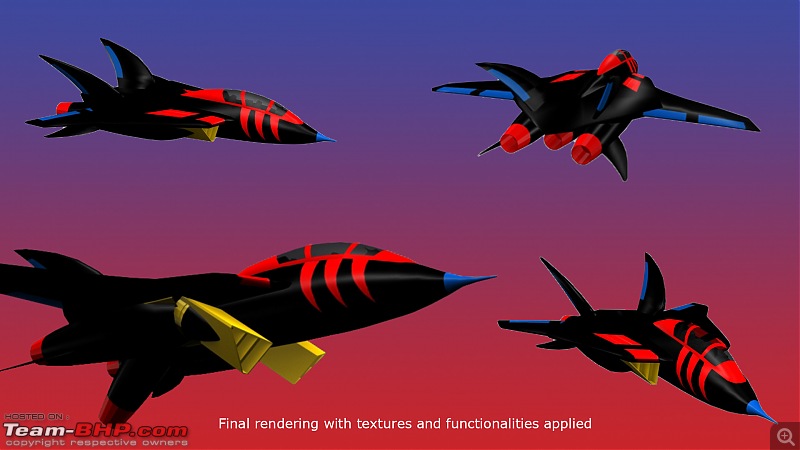 Chance "T-Bone" Furlong serves as the pilot of the Turbokat which he affectionately calls his baby. Jake "Razor" Clawson serves as the the weapons systems operator of the Turbokat. Unlike Chance, Jake is skinny and average size. His fur is rusty red.  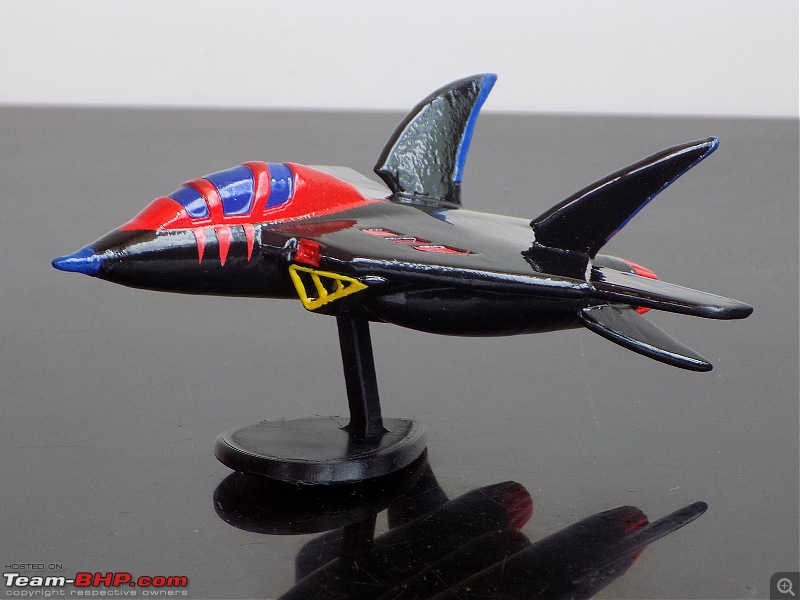     Inspiration from the Tomcat clearly visible     Ocean Low pass  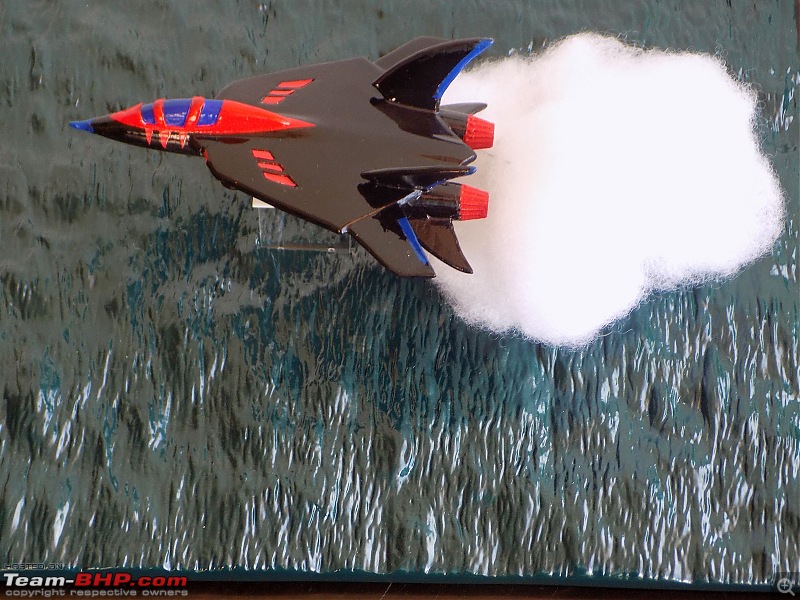 |
| |  (6)
Thanks (6)
Thanks
|
| The following 6 BHPians Thank skanchan95 for this useful post: | badboyscad, Foxbat, libranof1987, PaddleShifter, SnS_12, V.Narayan |
| | #1579 |
| Senior - BHPian Join Date: Jul 2010 Location: CHD
Posts: 1,232
Thanked: 2,911 Times
| Re: Scale Models - Aircraft, Battle Tanks & Ships SWAT kats was one of my favourite cartoon. We watched it in Hindi as broadcasted in our local area. The names were as follows: City: Mahabilla shehar (Mega Kat City). Pilot: Bade Meow (Big Kat) Co-Pilot: Chote Meow (Small Kat) The Bade Meow and Chote Meow were a reference to the Amitabh Bachan, Govinda starrer bollywood movie “Bade Miya, Chote Miya”. The SwatKat fighter Jet had a motorcycle just similar to the Batman’s BatMobile. Thanks for sharing this. |
| |  (2)
Thanks (2)
Thanks
|
| The following 2 BHPians Thank PaddleShifter for this useful post: | Foxbat, skanchan95 |
| | #1580 | |
| Senior - BHPian | Re: Scale Models - Aircraft, Battle Tanks & Ships Quote:
 In the mid or late 90s, Swat Kats used to be aired on Cartoon Network only in English. Star & Cartoon Network used to air some good animated series those days in the evenings - I dream of Genie, Batman 1966 series, Robotech, Teenage Mutant Ninja Turtles, Wonder Days , Different Strokes & many more. Pre-Satellite Dish era in the early 90s, the only good animated series aired on DD were G.I.Joe and Tom & Jerry on Sundays, with Street Hawk & Knight Rider serials in English too. Kids , these days get to watch silly cartons like Oggy & the cockroach & other silly animated series  Last edited by skanchan95 : 23rd September 2021 at 10:41. | |
| |  (3)
Thanks (3)
Thanks
|
| The following 3 BHPians Thank skanchan95 for this useful post: | DevilisH, FrozeninTime, PaddleShifter |
| | #1581 |
| BHPian Join Date: May 2009 Location: NYC / Lucknow
Posts: 709
Thanked: 4,168 Times
| Scale Models - Aircraft, Battle Tanks & Ships The Dassault Mirage 2000 is a French multirole, single-engined, fourth-generation jet fighter manufactured by Dassault Aviation. It was designed in the late 1970s as a lightweight fighter to replace the Mirage III for the French Air Force (Armée de l'air). The Mirage 2000 evolved into a multirole aircraft with several variants developed, with sales to a number of nations. It was later developed into the Mirage 2000N and 2000D strike variants, the improved Mirage 2000-5, and several export variants. Over 600 aircraft were built and it has been in service with 9 nations. In 1980, the Indian Air Force (IAF) learned of a successful approach by Pakistan to the US that year to purchase F-16A/B fighters, delivery of which was to commence in 1982. By late 1980, the IAF had quickly convinced the Indian government to purchase an equally potent aircraft, as its MiG-21s and MiG-23s were inferior to the F-16. When evaluating the Mirage F-1 earlier, they became aware of a high-performance prototype of the Mirage 2000 in the flight-testing phase. No other aircraft of this potential were in the offering. An internal assessment of the Mirage 2000 was carried out and the Indian government felt that the French plane was more advanced and a superior response to the F-16s that the US was to supply to Pakistan and approached France for 150 Mirage 2000s. In October 1982, the country placed an order with Dassault for 36 single-seat Mirage 2000Hs and four twin-seat Mirage 2000THs (with H standing for "Hindustan") with the possibility of a follow-on purchase of 9 aircraft (eight single- and one twin-seater aircraft) as war, maintenance and attrition reserve. The purchase of 150 aircraft, could well have paved the way for joint production with Hindustan Aeronautics Limited, but the number of aircraft ordered (40+9) was too small for such an arrangement. India nevertheless had the option to produce a number of Mirage 2000s under license that was later scrapped due to the country's close relationship with the Soviet Union. This led to the induction of the MiG-29, instead, overriding reservations expressed by the IAF. With the delivery of the first seven aircraft on 29 June 1985 to No. 7 Squadron, the Battleaxes, the Indian Air Force (IAF) became the first foreign user of the type, which it renamed the Vajra (Sanskrit: वज्र, for Lightning, Thunderbolt). The service's early aircraft were powered by Snecma M53-5 engines (so were designated Mirage 2000H5 and Mirage 2000TH5), which were quickly replaced by more-powerful M53-P2 engines. The second unit to convert to the type was No. 1 Squadron (the Tigers), which was formally designated a Mirage 2000 unit in January 1986. Within 12 months of the first delivery, the IAF had received all 40 aircraft ordered. The follow-on order of 9 aircraft was signed in 1986. Five aircraft were delivered by 1990, two more in 1992, and the last two aircraft were delivered in 1994. As such, full unit establishment was not achieved until 1990. 1/72 Scale Indian Air Force Mirage 2000H 'KF144' of the No.1 Tigers Squadron based in Gwalior.      The Real KF144. 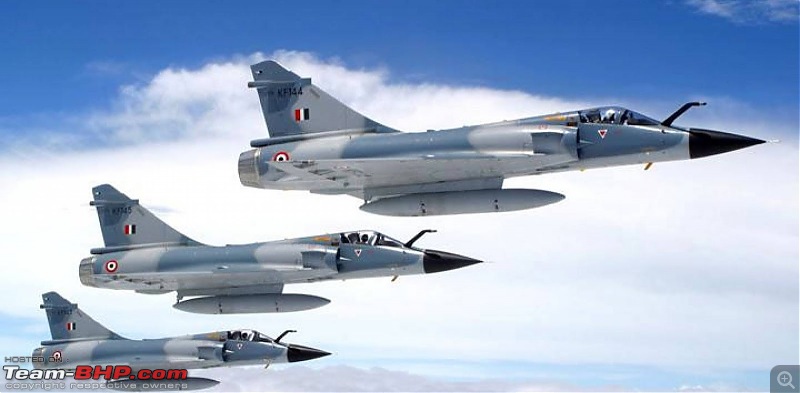  My Dassault Indian Air Force Collection.  |
| |  (5)
Thanks (5)
Thanks
|
| The following 5 BHPians Thank Foxbat for this useful post: | badboyscad, FrozeninTime, skanchan95, SnS_12, V.Narayan |
| | #1582 | |
| Senior - BHPian | Re: Scale Models - Aircraft, Battle Tanks & Ships Quote:
 . .Originally, IAF Mirage 2000s were delivered without the fixed IFR probes. It was only after the 1999 Kargil War(and around the time the IL-78s tankers arrived) that they got the IFR probes retro-fitted. 1:144 General Dynamics F-111A Aardvark USAF 474th TFW , 428th TFS, #66-0025, Takhli RTAFB, Thailand,1968 (Aviation 72) The F-111, built by General Dynamics, was a twin-engine tactical bomber, first flown in 1965. It was named Aardvark The F-111 (spelled F One Eleven) pioneered several technologies for production aircraft, including variable-sweep wings, afterburning turbofan engines, and automated terrain-following radar for low-level, high-speed flight. Its design influenced later variable-sweep wing aircraft, and some of its advanced features have since become commonplace. The F-111 suffered a variety of problems during initial development. A fighter variant, the F-111B, was not accepted for production. The F-111B was intended to perform aircraft carrier-based roles with the US Navy, including long-range interception and ability to carry AIM-54 missiles. USAF F-111s were retired during the 1990s with the F-111Fs in 1996 and EF-111s in 1998. The F-111 was replaced in USAF service by the F-15E Strike Eagle for medium-range precision strike missions, while the supersonic bomber role has been assumed by the B-1B Lancer. The RAAF continued to operate the type until December 2010, when the last F-111C was retired. The name Aardvark was derived from perceived similarities of the aircraft to the animal of the same name: a long nose and low-level, terrain-following capabilities. The word aardvark originated in the Afrikaans language, as a contraction of "earth-pig", and this was the source of the F-111's nickname of "Pig", during its Australian service. The F-111 could fly on complex terrain at extremely low altitude (about 70m) at high speed thanks to the terrain radar system and autopilot, accurately attack the target regardless of day and night, weather, could take off on short runways, operating radius of up to 5,800km and large payload capacity of 11.25 tons. The F-111 crew ejection system was unique in the sense that the cockpit was part of an escape crew capsule. The entire cabin ejected from rest of the fuselage where both side-by-side seats were in a single 3000 lb (1360 kg) capsule.  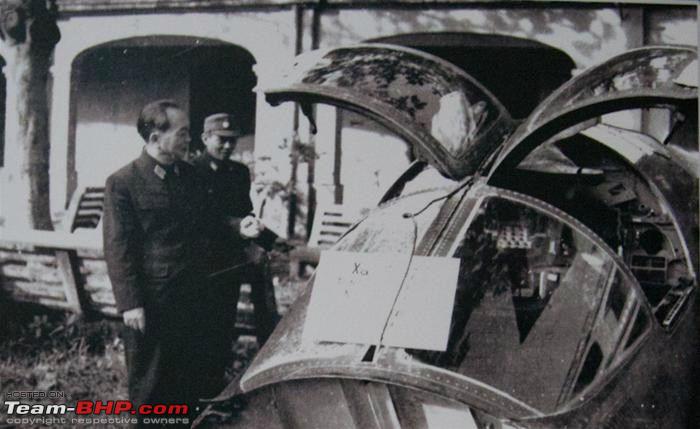 In early 1968, the US Air Force decided to send a small detachment of F-111As to Southeast Asia under the "Combat Lancer" program. Six 428th TFS Harvest Reaper F-111As were allocated to the Combat Lancer under "Detachment 1 under the command of Colonel Ivan H. Dethman, and they departed Nellis for Takhli Royal Thai Air Force Base on 15 March 1968. The 6 F-111s, accompanied by KC-135 tankers, departed for Andersen AFB, Guam. The over 13 hour trip was flown using the F-111's inertial navigation system and with topoff refueling from the tankers, arriving at Andersen AFB on the 16th.The Detachment departed Andersen and arrived at Takhli on 17 March. The Detachment was attached to the F-105 Thunderchief-flying 355th Tactical Fighter Wing in what was officially seen as the first stage in replacement of the Wing's F-105s with the F-111A. F-111 combat operations began on 25 March using the aircraft's unique terrain following radar (TFR) capability to conduct surprise night deep interdiction strikes. By the end of the deployment, 55 night low-level missions had been flown against targets in North Vietnam, but three aircraft had been lost. Aircraft 66022, call sign Omaha 77, had been lost on 28 March with the loss of the crew, Colonel Hank McCann and Captain Dennis Graham. On 30 March, the crew of Major Sandy Marquardt and Captain Joe Hodges in aircraft 66017, Hotrod 73, successfully ejected and was recovered uninjured in Thailand.Replacement aircraft had left Nellis, but a third loss halted F-111A combat operations. On 22 April, Tailbone 78, aircraft 66024, crewed by Lieutenant Commander Spade Cooley and by Lieutenant Colonel Ed Palmgren, was lost. After the 3rd loss, the Detachment remained poised for combat, but they saw no combat action before their return to the U.S. on 22 November. The Detachment and remaining aircraft returned to Nellis and development of the F-111 continued, with the 474th finally reaching operational status in 1971. In March 1973 it was reassigned to the 347th Fighter Wing and deployed back to Takhli, this time being placed on permanent party status in Thailand, taking over the aircraft the 430th TFS had left upon its return to the United States. For a brief period the 347th flew combat operations into Cambodia until 15 August, when the last wartime mission of the Vietnam Era was flown into Cambodia for final mission of Constant Guard. After the cease-fire, the wing was maintained in a combat-ready status for possible contingency            | |
| |  (4)
Thanks (4)
Thanks
|
| The following 4 BHPians Thank skanchan95 for this useful post: | badboyscad, Foxbat, FrozeninTime, V.Narayan |
| | #1583 |
| Senior - BHPian | Re: Scale Models - Aircraft, Battle Tanks & Ships 1:72 Folland Gnat F.Mk.1 GN-101 Finnish Air Force (Aviation 72) The Gnat was the creation of William Edward Willoughby "Teddy" Petter, a British aircraft designer who had gained wide recognition for his design of the English Electric Canberra bomber and other aircraft. Petter had grown suspicious of the trend towards bigger and more expensive combat aircraft, and he felt that a small, simple fighter would offer the advantages of low purchase and operational costs. The Gnat was armed with two 30 millimeter Aden revolver-type cannon, firing from the outer edge of the air intakes. While this arrangement might have suggested that the Gnat would be prone to engine flameouts from muzzle gas ingestion, that did not prove to be the case, suggesting that the muzzle system had been carefully designed to deflect the gases out to the sides. The Gnat also had two stores pylons for drop tanks, 225 kilogram (500 pound) bombs, or unguided rocket pods. The evaluation Gnats were powered by the production-spec Bristol Orpheus 701 turbojet with 20.1 kN (2,042 kgp / 4,502 lbf) thrust. Most of the test flights were conducted in the UK, though ground-attack trials were performed in Aden (now Yemen). The report from the RAF evaluation generally praised the Gnat's performance, but there were criticisms of its flight-control systems, and there was no consensus that the Gnat was what the RAF needed. Midge had a number of advanced features, such as hydraulically powered "flaperons", main gear that could be used as airbrakes, and a one-piece canopy that hinged over an inner armored windscreen. Despite the underpowered engine, the little jet could break Mach 1 in a dive and was very agile. The good press given the Gnat opened the way for export sales. Gnat F.Mk.1s were sold to India, Finland and Yugoslavia. India was also interested in a naval version of the Gnat but in an ironic turn of events, it was found that the aircraft was too light - the catapult gear on the INS Vikrant, the Indian Navy's aircraft carrier, needed a 10,000lb weight minimum! Finnish Gnats The Finnish Air Force acquired 13 Folland Gnat F.1 aircraft in 1958-1960. They were coded GN-101 to GN-113. Two of the aircraft, GN-112 and GN-113, were photographic versions ('FR.1') equipped for reconnaissance. The Gnats of the Finnish Air force were used from 1958 to 1974. The first two aircraft arrived on 30th July 1958 for the Fighter Squadron 21 (HävLv 21). The next day Major Lauri Pekuri exceeded the speed of sound as the first Finn in the Finnish airspace. One of the Gnats (GN-102) was destroyed due to a technical fault on 26th August 1958. The Gnats were grounded, and only in January 1959 did they fly again, after thorough investigations and rectifications. A public debate that had begun in the press even before the aircraft's arrival was fueled by the accident and contributed to the fact that no more Gnats were purchased and license production that had first been planned was not started in Finland. Finnish pilots liked the Gnat but the longitudinal instabilities did give rise to some concern and it had to be carefully handled. Many snags and deficiencies emerged in Gnats in the early stages of their service, and continuous modification work was necessary to ensure flying safety. In 1961 HävLv 21 that flew the Gnats was renamed HävLv 11 (Fighter Squadron 11). In 1967 the Gnats were replaced by MiG-21Fs. The Gnats were used as trainers but they were still fully operational and armed. They were finally retired from Finnish service in 1974.        With the IAF Gnat/Ajeet :       Gnat F.Mk.1 GN-101 "Kreivi von Rosen" (Count von Rosen) is on display at the Aviation Museum of Central Finland.  In the PC Flight Sim Strike Fighters 2. I was proudly associated with the development of this aircraft mod(Gnat & Ajeet) for the flight sim - a mod that was build 14-15 years ago. It remains the only fully developed & flyable Gnat F.1 & Ajeet mod ever made for a PC flight sim.   Last edited by skanchan95 : 15th October 2021 at 12:11. |
| |  (4)
Thanks (4)
Thanks
|
| The following 4 BHPians Thank skanchan95 for this useful post: | badboyscad, Foxbat, SnS_12, V.Narayan |
| | #1584 |
| Senior - BHPian | Re: Scale Models - Aircraft, Battle Tanks & Ships 1:72 Dassault Mirage 2000-5Di S/N 2059/DI09, 2nd Tactical Fighter Wing, Republic of China Air Force, Hsinchu Airport 2019 (Panzerkampf) The ROCAF was the first foreign customer for the Mirage 2000-5 and MICA missiles. The Taiwanese Mirages did not get IFR probes and ground attack capability was deleted. The Mirage 2000-5 is a major advancement over the previous variants of the aircraft, and embodies a comprehensive electronic, sensor, and cockpit upgrade to expand its combat ability, while reducing pilot workload. The centrepiece of the Mirage 2000-5 overhaul is the Thomson-CSF RDY (radar Doppler multitarget) with look down/shoot down capability. The multifunction radar is capable of air-to-ground, air-to-air, and air-to-sea operations. In the air-to-ground mode, the RDY has navigation and attack functions that give it deep-strike and close-support capabilities. Capable of automatically locking onto multiple targets at first contact, the radar could detect flying targets travelling as low as 200 ft. The introduction of the radar allows the aircraft to use the MICA missile, up to six of which could be fired simultaneously at targets due to the advances within the radar. Despite the increase in offensive capability, pilot workload is compensated for by the introduction of a multidisplay glass cockpit, based on the development of the Rafale. The aircraft has the ICMS Mk2 countermeasures suit, which contains three radar detectors and an infrared sensor that are linked to active jammers and chaff/flare dispensers. Improvements over the Mirage 2000C included the Thales TV/CT CLDP laser designator pod and the multimode RDY, which allows detection of up to 24 targets and the ability to simultaneously track eight threats while guiding four MICA missiles to different targets. Updates to defensive systems included the ICMS 2 countermeasures suite and the Samir DDM missile warning system. ICMS 2 incorporates a receiver and associated signal processing system in the nose for detecting hostile missile-command data links, and can be interfaced to a new programmable mission-planning and postmission analysis ground system. Avionics were also updated, using a new night vision-compatible glass cockpit layout borrowed from the Dassault Rafale, a dual-linked wide-angle head-up display, and HOTAS controls. The Mirage 2000-5 can also carry the oversized drop tanks developed for the Mirage 2000N, greatly extending its range. In response to mainland China's purchase of the Su-27, the Republic of China (Taiwan) began talks with the US and France about the possible purchase of new fighters. France announced in 1992 that it would offer Dassault Mirage 2000-5 fighters to Taiwan. While the US opposed Taiwan's acquisition of the Mirage 2000 and instead pressured it to procure the F-16, the Republic of China Air Force became the first customer for the Mirage 2000-5 in November 1992. The order for 48 single-seat Mirage 2000-5EIs and 12 Mirage 2000-5DI trainers was condemned by China. The number of aircraft considered had been rumored to be 120, but the deal was finalized as 60 aircraft (48 single-seat 2000-5Ei and 12 two-seat 2000-5Di) on November 17 of the same year. This marked the first ROCAF purchase of French fighters since the arrival 24 Dewoitine D.510C piston-engine monoplanes in 1937. The program was given the codename "Fei Lung" (Flying Dragon). ROCAF also obtained 960 MICA medium-range and 480 Magic II short-range air-to-air missiles from Matra. The former provides the Mirage with the BVR capability needed for its role as front-line interceptor. A number of centerline twin gun pods with DEFA 554 cannons were also acquired and fitted on the two-seaters, as they do not have an internal gun armament. Other support equipment, such as auxiliary fuel tanks, helmets, and G-suits, have also been procured. The first batch of ROCAF Mirage 2000-5, consisting of five aircraft, arrived at Hualien Harbor on the east coast of Taiwan by sea on May 6, 1997. After being unloaded, they were towed to Hualien AB, where they were unpacked and checked, and then flown to Hsinchu AB. Subsequent deliveries also followed the same procedure. The last ROCAF Mirage 2000-5 was delivered in an official ceremony on November 26, 1998. All Mirage 2000-5 are operated by the 499th TFW at Hsinchu. The first unit to conver to the type, the 41st TFS, was commissioned on December 1, 1997. Subsequently the 42nd TFS was commissioned on November 26, 1998. The 499th TFW achieved the IOC (Initial Operational Capability) status on May 10, 2001, and the 48th TFS was commissioned on the same day. On November 1, 2004, the 41st and 42nd TFS were upgraded to the TFG status while the 48th TFS became the 48th Training Group, in the largest restructure undertaken by ROCAF since 1999. At the same time, the original 11th TFG went into history. Each of the new TFG/TG is commanded by a Colonel, but the number of aircraft assigned is not much different from that for a Squadron. Although their official English designation is Tactical Fighter Group, the Chinese designation literally means Operations Group. The Model This first Panzerkampf 1:72 Fighter model and must say I am pretty impressed with it. The attachments fit pretty easily and stay in place(unlike JC or some other brands). In that aspect, it is almost Hobbymaster-esque. Pretty nice detailing on their Mirage 2000 model, but the panel lines are too deep/prominent for my liking. A couple of minor paint defects on the model, but nothing alarming. The loadout is fantastic - 2 X Magics IIs , 2 X MICA IRs ,2 X MICA EMs & 3 X Mirage 2000 Drop tanks  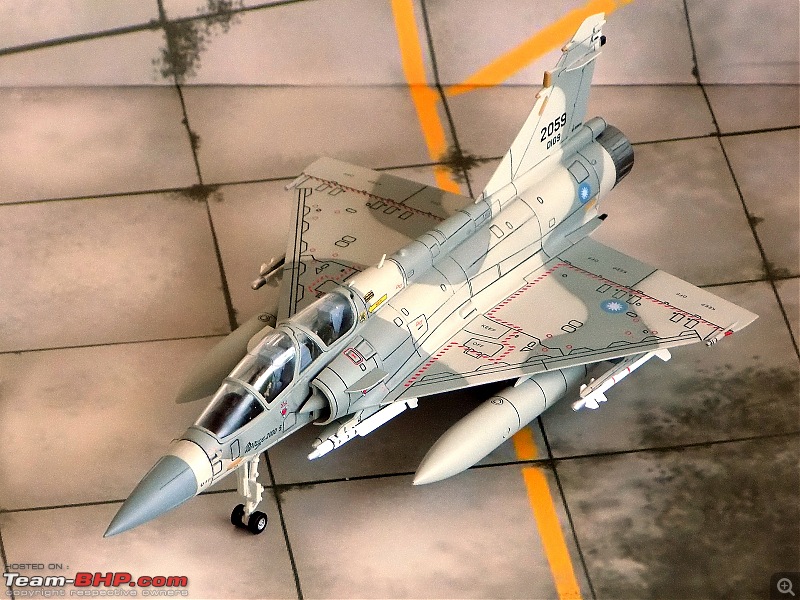       Detailing:    Scramble! Scramble! Scramble!      The Original & its ultimate evolution    ROCAF Mirage 2000-5Di 2059/DI09  Last edited by skanchan95 : 16th October 2021 at 16:37. |
| |  (5)
Thanks (5)
Thanks
|
| The following 5 BHPians Thank skanchan95 for this useful post: | badboyscad, DevilisH, Foxbat, FrozeninTime, V.Narayan |
| | #1585 | ||
| Distinguished - BHPian  Join Date: Aug 2014 Location: Delhi-NCR
Posts: 4,330
Thanked: 72,462 Times
| Re: Scale Models - Aircraft, Battle Tanks & Ships Quote:
 Quote:
 The comparison with your Mirage III is telling. Within a similarly sized airframe and wing so much more is achieved in the -2000 versus its grandfather the -III all due to technology and advanced wing design. Congratulations! Another first for this thread is it? - the F-111. A F-111 built today with new engines and avionics and with the same airframe would bae an unbeatable long range strike aircraft. Alas it was messed up by the US Secretary Robert McNarama with his assinine insistence on a fighter + bomber + carrier capable + common aircraft for USN and USAF. Nevertheless it introduced more technology in one go than any aircraft before. Last edited by V.Narayan : 17th October 2021 at 08:30. | ||
| |  (2)
Thanks (2)
Thanks
|
| The following 2 BHPians Thank V.Narayan for this useful post: | Foxbat, skanchan95 |
| | #1586 | ||
| Senior - BHPian | Re: Scale Models - Aircraft, Battle Tanks & Ships Quote:
Panzerkampf has come a long way in the last 3-4 years. They started out as a cheap small scale model manufacturer and have now graduated to good quality 1:72 Rafale & Mirage 2000 models & high quality Tank & military vehicle models. Among Panzerkampf's old models, I have the 1:250 US-2, 1:100 RF-4E and a 1:72 T-90 - all of them though quite good but their generation of models are miles ahead of them. Quote:
1:43 PT-76 Light Tank (Modimio) The PT-76 was a Soviet amphibious light tank that was introduced in the early 1950s and soon became the standard reconnaissance tank of the Soviet Army and the other Warsaw Pact armed forces. It was widely exported to other friendly states, like India, Iraq, Syria, North Korea and North Vietnam. The tank's full name is Floating Tank–76 (плавающий танк, plavayushchiy tank, or ПТ-76). 76 stands for the caliber of the main armament: the 76.2 mm D-56T series rifled tank gun. The PT-76 is used in the reconnaissance and fire-support roles. Its chassis served as the basis for a number of other vehicle designs, many of them amphibious, including the BTR-50 armored personnel carrier, the ZSU-23-4 self-propelled antiaircraft gun, the ASU-85 airborne self-propelled gun and the 2K12 Kub anti-aircraft missile launch vehicle. PT-76 & its Indian connection In the early 1960s, against the backdrop of the 1962 Indo-China war and disappointed by the denial of top of the line western Military hardware (Supersonic fighters/modern tanks/ships/submarines/guns etc), the Indian government turned to the Soviet Union for support. The Soviets were more than happy to support Indian military requirements and later the Indo-Soviet treaty of Friendship was signed which opened the gates for license manufacturing of Soviet military hardware in India. To fulfil the Indian armoured vehicle requirement, the Soviets supplied PT-76, T-54 & T-55 Main battle tanks to India from 1965 onwards. A few PT-76s came in just before the start of the 1965 war and these were rushed into service during the 1965 Indo-Pak War. The T-54 & T-55s, however, came much later, and by 1967 all Soviet tank deliveries from the initial order were complete. The PT-76 was a light & amphibious tank. Its primary armament was the 76.2 mm D-56T rifled tank gun and a 7.62mm coaxial machine gun as its secondary armament. 7th Light Cavalry was the first Indian Army Armored Corps Regiment to equip with PT-76s in August 1965. They had about 45 PT-76s which they went to war with in 1965. After the 1965 War, India went on to order more PT-76 amphibious tanks. By the time the 1971 war started, the Indian Army had four PT-76 regiments The 63rd Cavalry had a mix of T-55 & PT-76 tanks and took part in the Eastern theater of operations in the 1971 war. The tendency of their tanks to appear suddenly from any of the four directions led to the Pakistanis giving it the epithet of the "Ghost" regiment. While advancing through East Pakistan, Indian Army units were able to able to capture abandoned & intact Pakistan’s Indonesian supplied PT-76s and used it against their former operators!!! Battle of Garibpur On 21 November,1971 the Indian Army's 14 Punjab Battalion – supported by PT-76 tanks from 45 Cavalry and Mukti Bahini moved in to capture the areas around Garibpur inside East Pakistan territory. The move was supposed to be a surprise, but following a skirmish with patrol troops of both armies the previous day, Pakistan was alerted to this impending attack. Pakistan immediately retaliated with its infantry battalion supported by 3rd Independent Armoured Squadron, equipped with M24 Chaffee light tanks was launched. Retaining the Infantry and the Recoilless rifles in a defensive position, the tanks were sent forward to ambush the oncoming Pakistani charge. In the next couple of hours Indian troops resisted the Pakistani attack who couldn't pinpoint the source of attacks due to poor visibility on account of fog. Undeterred, Pakistan tanks and infantry were thrown into an offensive against Indian defensive positions in a Frontal Assault. The resulting battle is now famous as the Battle of Garibpur. As Pakistani troops were unable to dislodge entrenched enemy, the Mitro Bahini and the Indian Army, the Pakistani Army called in close air support. The Pakistani Air Force Contingent in Dhakka responded by launching several sorties of Canadair Sabre Mk6s beginning on the morning of 22 November 1971. During the battle, 8 Pakistani M24 Chaffee tanks were destroyed, 3 captured at the cost of 2 Indian PT-76s. This set the stage for the Battle of Boyra - which resulted in the IAF Gnats shooting down three PAF F-86s.    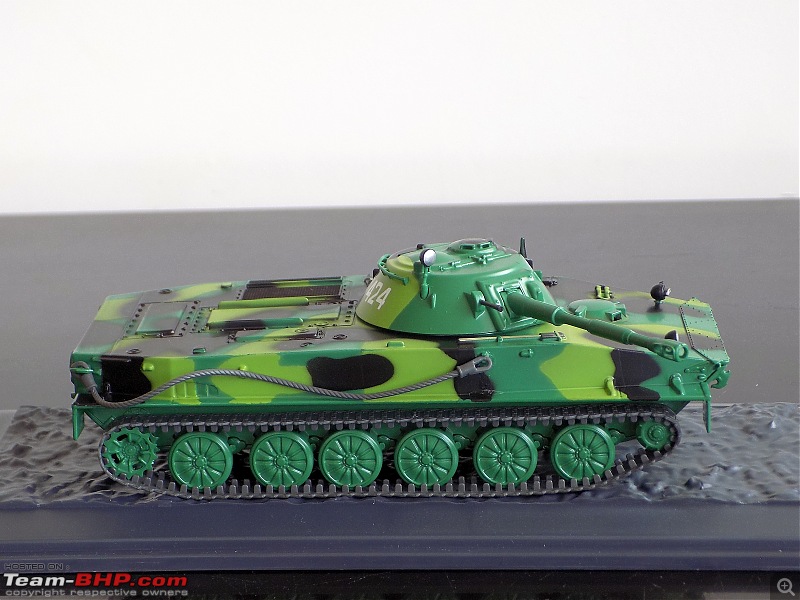       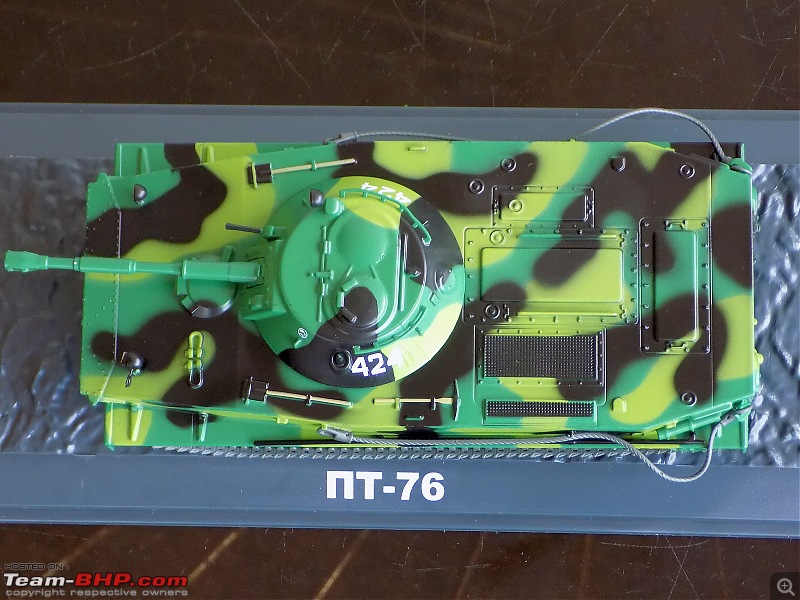 Indian PT-76s rolling towards future Bangladeshi capital of Dacca.  | ||
| |  (3)
Thanks (3)
Thanks
|
| The following 3 BHPians Thank skanchan95 for this useful post: | badboyscad, Foxbat, V.Narayan |
| |
| | #1587 |
| Senior - BHPian | Re: Scale Models - Aircraft, Battle Tanks & Ships 1:43 T-55 Main Battle Tank (Modimio) The T-54/55 series is the most-produced tank in history. Estimated production numbers for the series range from 86,000 to 100,000. They were replaced by the T-62, T-64, T-72, T-80 and T-90 tanks in the Soviet and Russian armies, but remain in use by up to 50 other armies worldwide, some having received sophisticated retrofitting. T-55 & its Indian connection The T-54/T-55 Main Battle Tank was armed with a 100 mm rifled gun (43 rounds) as its primary armament & a secondary 7.62 mm coaxial machine gun or a 12.7 mm heavy machine gun. The T-54 and T-55 tanks are outwardly very similar and difficult to distinguish visually. 14 Horse (The Scinde Horse) was the first Indian Army Armored Corps Regiment to equip with T-55s in 1966. While India continued to receive Soviet military equipment after the 1965 War, Pakistani acquisitions suffered because they were much dependent on the US and the sanctions imposed by US made it even worse. Pakistan briefly flirted with the Soviet Union in the late 60s, and received a few T-54s and helicopters (Mi-6 & Mi-8) from them. However, it was China that literally donated them with bulk of the military hardware they eventually fielded in the 1971 war. The Pakistanis also bought a few PT-76s second hand from Indonesia in the late 1960s. They also received a large number of Chinese built Type 59 tanks (Chinese copy of the T-54 tank). As a result, both the Indian & Pakistani Army Armoured Regiments had more or less the same type of tank. The Indian Army, in an attempt to distinguish Indian T-54/55s from Pakistan T-54/Type 59s, affixed fake fume extractors to its T-54 and T-55 main guns so that its gunners would not confuse them with Pakistani T-54/Type 59s (Later Indian T-55s were up-gunned with the Vijayanta Tank's 105 mm Guns which had real fume extractors) Pakistani Army T-54s and Type 59 tanks got mauled by IAF Hunters during Battle of Longewala in the 1971 war and the battle was picturized in the Bollywood movie - Border, albeit somewhat inaccurately. Eventhough the T-54s & T-55s were supplied in large numbers, Indian tank crews preferred the lighter and more reliable Centurion & Vijayanta tanks over the Soviet built tanks.    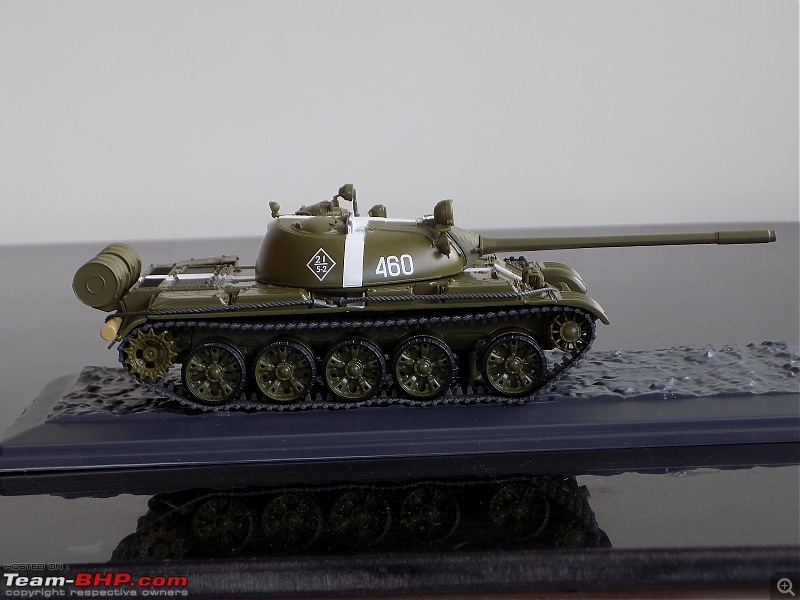         This Soviet Army T-55 "460" tank took part in the Soviet Union led Warsaw Pact invasion of Czechoslovakia to crack down on reformist trends in Prague. The photo is titled - Czech citizen throwing a brick at a Soviet T-55 tank, the Prague Spring, 1968          With the Hobbymaster 1:72 T-55 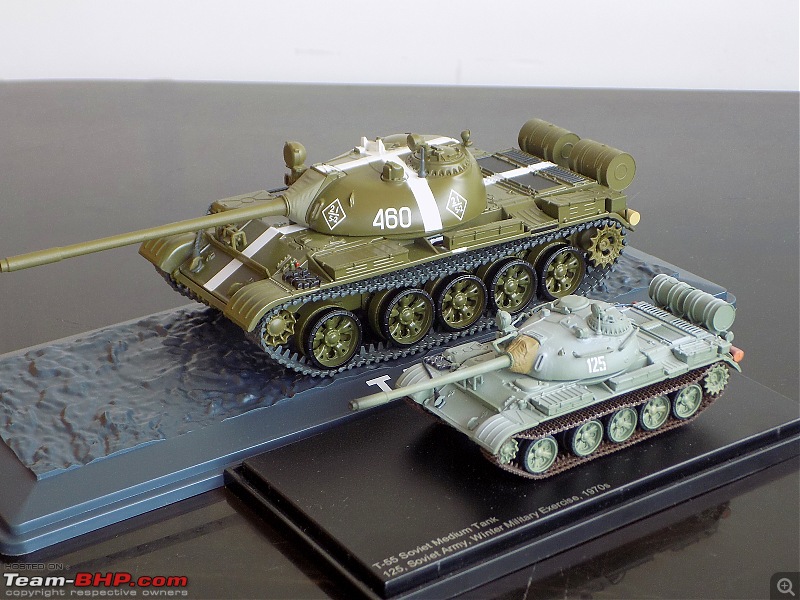  |
| |  (3)
Thanks (3)
Thanks
|
| The following 3 BHPians Thank skanchan95 for this useful post: | badboyscad, Foxbat, V.Narayan |
| | #1588 |
| Senior - BHPian | Re: Scale Models - Aircraft, Battle Tanks & Ships    Sandesh's 95th Independent Armoured Squadron         The T-series tanks that served/are serving the Indian Armoured Corps - T-55, T-72, T-90   Last edited by skanchan95 : 18th October 2021 at 11:18. |
| |  (3)
Thanks (3)
Thanks
|
| The following 3 BHPians Thank skanchan95 for this useful post: | badboyscad, Foxbat, V.Narayan |
| | #1589 |
| Distinguished - BHPian  Join Date: Aug 2014 Location: Delhi-NCR
Posts: 4,330
Thanked: 72,462 Times
| Re: Scale Models - Aircraft, Battle Tanks & Ships
Sandesh these tank models of yours are to die for. They just look so well sculpted and presented. You just might convert me from an aircraft infidel to a tank true believer. :-) . Love the quality. The Russians knew & still know how to make tanks and balance firepower-mobility-armour/protection mix. The others are the Germans. In the 1970s and 80s I read so often scathing criticism of those fuel drums at the rear by Western writers. today everyone imitates it. The PT-76 was criticized as a tin can when used by the North Vietnamese against the US Army. But it was a huge asset for us in riverine East Pakistan. And once again you are a good photographer. I need to learn from your style.  |
| |  (1)
Thanks (1)
Thanks
|
| The following BHPian Thanks V.Narayan for this useful post: | Foxbat |
| | #1590 | |
| BHPian Join Date: May 2009 Location: NYC / Lucknow
Posts: 709
Thanked: 4,168 Times
| Re: Scale Models - Aircraft, Battle Tanks & Ships Quote:
The F-111 looks like a really well detailed model for a 1/144 Scale. I Guess a shoot of your 1:144 collection is due ! Its amazing to think that such a huge and heavy aircraft was capable from operating from aircraft carriers. In Vietnam I was wondering what could be the reason for loss of the three aircraft, did any Vietnamese pilots claim F-111s or some unidentifiable aircraft during the same time period ? The Mikoyan-Gurevich MiG-23 (Russian: Микоян и Гуревич МиГ-23; NATO reporting name: Flogger) is a variable-geometry fighter aircraft, designed by the Mikoyan-Gurevich design bureau in the Soviet Union. It is a third-generation jet fighter, alongside similar Soviet aircraft such as the Su-17 "Fitter". It was the first Soviet fighter to field a look-down/shoot-down radar, the RP-23 Sapfir, and one of the first to be armed with beyond-visual-range missiles. Production started in 1969 and reached large numbers with over 5,000 aircraft built, making it the most produced variable-sweep wing aircraft in history. Today the MiG-23 remains in limited service with some export customers. The MiG-23 MF was one of the first IAF fighters to be equipped with the R-23 R and R-23T beyond visual range air-to-air missiles. In their two and half decades of operations the Warlords squadron participated in various operations, including Operation Meghdoot in the Air Defence of Siachen glacier area in the mid-1980s. In a unique first, the squadron had the rare distinction of having operated from Leh, the highest airfields in India, located at 11,000 feet above mean sea level. The squadron was also the first fighter to ever operate from those airfields in Ladakh which, owing to their high altitude, limit the performance of the aircraft, thereby reducing the margin for error considerably. After having lorded the skies for almost 24 years and logging nearly 32,581 flying hours, the 224 squadron of the Indian Air Force (IAF), christened Warlords, ended their tryst with the veritable 'air superiority fighter' of its time, the MiG-23 MF, at the Jamnagar airbase in Gujarat in 2007. 1/72 Scale Indian Air Force Mig-23MF "Rakshak" SK415 of the No.224 Warlords Squadron.    Pictures of similar aircraft when they were freshly repainted grey.  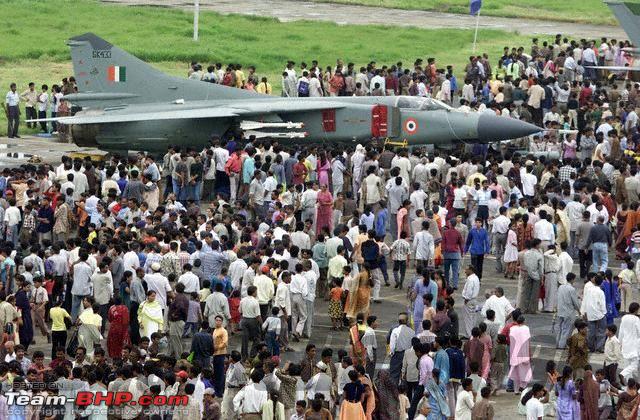 "Floggers" of the Indian Air Force, Mig-27 'Bahadur' and Mig-23 'Rakshak'   Last edited by Foxbat : 23rd October 2021 at 19:42. | |
| |  (5)
Thanks (5)
Thanks
|
| The following 5 BHPians Thank Foxbat for this useful post: | badboyscad, FrozeninTime, sajands, skanchan95, V.Narayan |
 |


